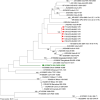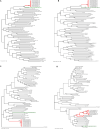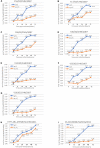Molecular Epidemiological, Serological, and Pathogenic Analysis of EV-B75 Associated With Acute Flaccid Paralysis Cases in Tibet, China
- PMID: 33584598
- PMCID: PMC7873985
- DOI: 10.3389/fmicb.2020.632552
Molecular Epidemiological, Serological, and Pathogenic Analysis of EV-B75 Associated With Acute Flaccid Paralysis Cases in Tibet, China
Abstract
Enterovirus B75 (EV-B75) is a newly identified serotype of the enterovirus B species. To date, only 112 cases related to EV-B75 have been reported worldwide, and research on EV-B75 is still limited with only two full-length genome sequences available in GenBank. The present study reported seven EV-B75 sequences from a child with acute flaccid paralysis and six asymptomatic close contacts in Shigatse, Tibet. Phylogenetic analysis revealed that the Tibetan strain was possibly imported from neighboring India. Seroepidemiological analyses indicated that EV-B75 has not yet caused a large-scale epidemic in Tibet. Similarity plots and boot scanning analyses revealed frequent intertypic recombination in the non-structural region of all seven Tibet EV-B75 strains. All seven Tibetan strains were temperature-sensitive, suggesting their poor transmissibility in the environment. Overall, though the seven Tibetan strains did not cause large-scale infection, prevention and control of the novel enterovirus cannot be underestimated.
Keywords: Tibet; enterovirus B75; phylogenetic analyses; seroprevalence; temperature sensitivity.
Copyright © 2021 Zhang, Hong, Zhang, Han, Xiao, Lu, Song, Yan, Wang, Zhu, Xu and Wu.
Conflict of interest statement
The authors declare that the research was conducted in the absence of any commercial or financial relationships that could be construed as a potential conflict of interest.
Figures





Similar articles
-
Phylogenetic evidence for multiple intertypic recombinations in enterovirus B81 strains isolated in Tibet, China.Sci Rep. 2014 Aug 12;4:6035. doi: 10.1038/srep06035. Sci Rep. 2014. PMID: 25112835 Free PMC article.
-
Molecular typing and characterization of a novel genotype of EV-B93 isolated from Tibet, China.PLoS One. 2020 Aug 25;15(8):e0237652. doi: 10.1371/journal.pone.0237652. eCollection 2020. PLoS One. 2020. PMID: 32841272 Free PMC article.
-
Phylogenetic analysis and phenotypic characterisatics of two Tibet EV-C96 strains.Virol J. 2019 Mar 29;16(1):40. doi: 10.1186/s12985-019-1151-7. Virol J. 2019. PMID: 30922336 Free PMC article.
-
Genetic characterization and molecular epidemiological analysis of novel enterovirus EV-B80 in China.Emerg Microbes Infect. 2018 Nov 28;7(1):193. doi: 10.1038/s41426-018-0196-9. Emerg Microbes Infect. 2018. PMID: 30482903 Free PMC article.
-
A novel interspecies recombinant enterovirus (Enterovirus A120) isolated from a case of acute flaccid paralysis in China.Emerg Microbes Infect. 2020 Dec;9(1):1733-1743. doi: 10.1080/22221751.2020.1796527. Emerg Microbes Infect. 2020. PMID: 32672504 Free PMC article.
Cited by
-
Unraveling the multiple interactions between phages, microbes and flavor in the fermentation of strong-flavor Baijiu.Bioresour Bioprocess. 2025 Mar 5;12(1):14. doi: 10.1186/s40643-025-00852-1. Bioresour Bioprocess. 2025. PMID: 40042720 Free PMC article.
-
Harnessing bacterial metabolites for enhanced cancer chemotherapy: unveiling unique therapeutic potentials.Arch Microbiol. 2024 Oct 29;206(11):449. doi: 10.1007/s00203-024-04179-x. Arch Microbiol. 2024. PMID: 39472338 Review.
-
Deep learning in the discovery of antiviral peptides and peptidomimetics: databases and prediction tools.Mol Divers. 2025 Aug;29(4):3753-3788. doi: 10.1007/s11030-025-11173-y. Epub 2025 Mar 28. Mol Divers. 2025. PMID: 40153158 Review.
References
LinkOut - more resources
Full Text Sources
Other Literature Sources

